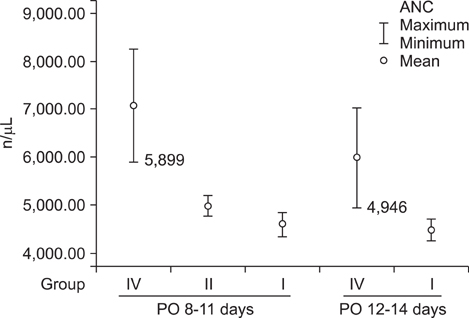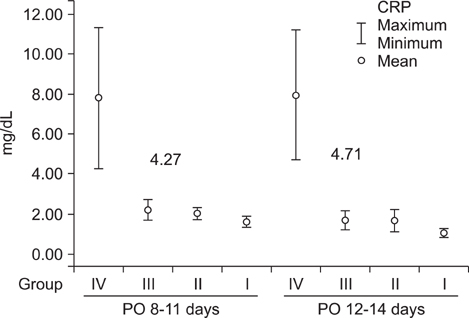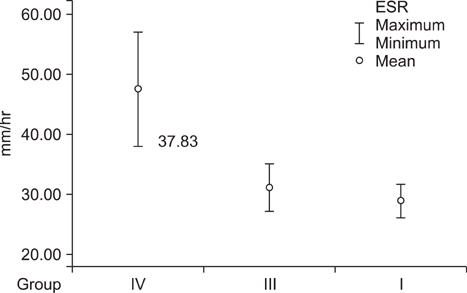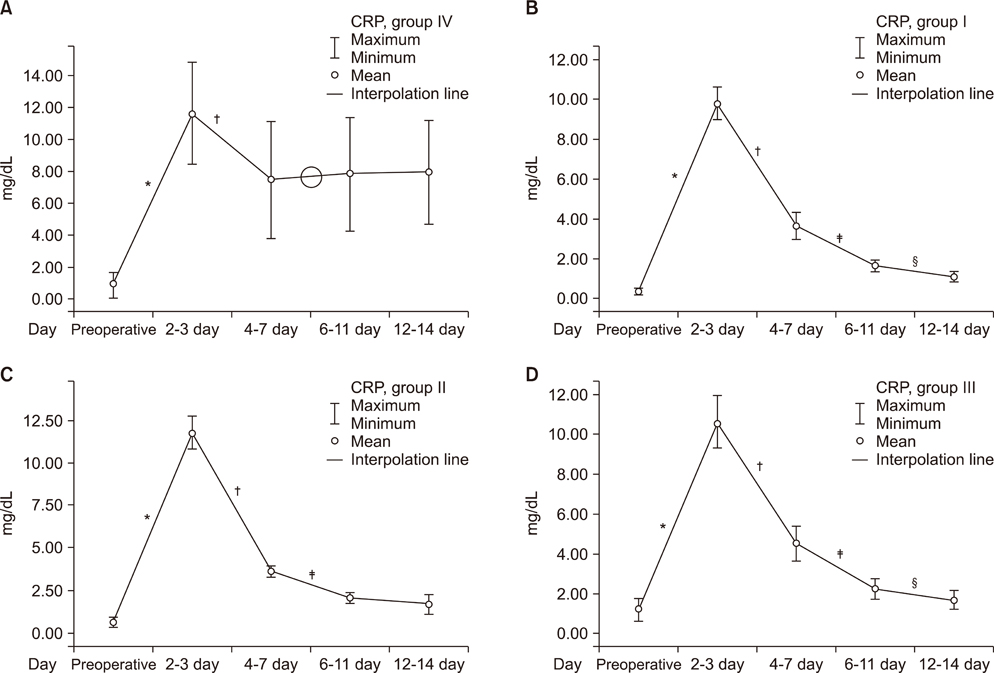Clin Orthop Surg.
2012 Dec;4(4):269-277. 10.4055/cios.2012.4.4.269.
Normal Range of the Inflammation Related Laboratory Findings and Predictors of the Postoperative Infection in Spinal Posterior Fusion Surgery
- Affiliations
-
- 1Department of Orthopedic Surgery, Seoul Metropolitan Government Seoul National University Boramae Medical Center, Seoul National University College of Medicine, Seoul, Korea. spinelee@snu.ac.kr
- 2Institute of Medical and Biological Engineering, Seoul National University Medical Research Center, Seoul, Korea.
- KMID: 1719294
- DOI: http://doi.org/10.4055/cios.2012.4.4.269
Abstract
- BACKGROUND
Inflammation related hematological parameters vary greatly depending on patients. It is not well known how much increase of which parameter warrants suspicion of postoperative infection. This study proposes to identify the normal range and the predictive factors for postoperative infection by conducting a time series analysis of the hematological parameters of patients after the spinal posterior fusion.
METHODS
A retrospective study was done with 608 patients who underwent spinal posterior fusion with pedicle screw fixation. Laboratory assessment including the leucocyte, neutrophil, C-reactive protein (CRP), and erythrocyte sedimentation rate (ESR) of patients for 2 weeks after operation. The patients were divided into the one-level fusion group (group I), the two-level fusion group (group II), the three or multi-level fusion or reoperation group (group III), and the postoperative infection group (group IV). Blood was drawn before breakfast prior to the operation, and then 2-3 days, 4-7 days, 8-11 days, and 12-14 days after the operation. The leucocyte count, neutrophil count, CRP, and ESR were measured.
RESULTS
From 4-7 days after the operation, the CRP and neutrophil count of group IV were significantly higher than those of group I and II, and from 8-11 days after operation, the CRP and neutrophil counts were significantly higher than those of all groups. Twelve to fourteen days after the operation, the neutrophil count of group IV was significantly higher than that of group I and II, while the neutrophil count of group III was also higher than that of group I. The lower limit of the 95% confidence interval (CI) of the CRP and neutrophil count group IV was greater than the upper limit of the 95% CI of group I and II. The ESR of group IV was significantly higher than that of group I and III.
CONCLUSIONS
If the postoperative CRP and neutrophil counts are high, or if the CRP begins to rise again 8 days after the operation, the likelihood of infection increases, but caution must be exercised in interpreting the results. If the hematological parameters are higher than the lower limit of the 95% CI of the postoperative infection group, infection must be strongly suspected.
Keyword
MeSH Terms
Figure
Reference
-
1. Abbey DM, Turner DM, Warson JS, Wirt TC, Scalley RD. Treatment of postoperative wound infections following spinal fusion with instrumentation. J Spinal Disord. 1995. 8(4):278–283.
Article2. Takahashi J, Ebara S, Kamimura M, et al. Early-phase enhanced inflammatory reaction after spinal instrumentation surgery. Spine (Phila Pa 1976). 2001. 26(15):1698–1704.
Article3. Zucherman J, Hsu K, White A, Wynne G. Early results of spinal fusion using variable spine plating system. Spine (Phila Pa 1976). 1988. 13(5):570–579.
Article4. Keller RB, Pappas AM. Infection after spinal fusion using internal fixation instrumentation. Orthop Clin North Am. 1972. 3(1):99–111.
Article5. Aono H, Ohwada T, Kaneko N, Fuji T, Iwasaki M. The post-operative changes in the level of inflammatory markers after posterior lumbar interbody fusion. J Bone Joint Surg Br. 2007. 89(11):1478–1481.
Article6. Black S, Kushner I, Samols D. C-reactive protein. J Biol Chem. 2004. 279(47):48487–48490.
Article7. Vigushin DM, Pepys MB, Hawkins PN. Metabolic and scintigraphic studies of radioiodinated human C-reactive protein in health and disease. J Clin Invest. 1993. 91(4):1351–1357.
Article8. Thelander U, Larsson S. Quantitation of C-reactive protein levels and erythrocyte sedimentation rate after spinal surgery. Spine (Phila Pa 1976). 1992. 17(4):400–404.
Article9. Larsson S, Thelander U, Friberg S. C-reactive protein (CRP) levels after elective orthopedic surgery. Clin Orthop Relat Res. 1992. (275):237–242.10. Neumaier M, Metak G, Scherer MA. C-reactive protein as a parameter of surgical trauma: CRP response after different types of surgery in 349 hip fractures. Acta Orthop. 2006. 77(5):788–790.11. Scherer MA, Neumaier M, von Gumppenberg S. C-reactive protein in patients who had operative fracture treatment. Clin Orthop Relat Res. 2001. (393):287–293.
Article12. White J, Kelly M, Dunsmuir R. C-reactive protein level after total hip and total knee replacement. J Bone Joint Surg Br. 1998. 80(5):909–911.
Article13. Mok JM, Pekmezci M, Piper SL, et al. Use of C-reactive protein after spinal surgery: comparison with erythrocyte sedimentation rate as predictor of early postoperative infectious complications. Spine (Phila Pa 1976). 2008. 33(4):415–421.
Article14. Jonsson B, Soderholm R, Stromqvist B. Erythrocyte sedimentation rate after lumbar spine surgery. Spine (Phila Pa 1976). 1991. 16(9):1049–1050.
Article15. Foglar C, Lindsey RW. C-reactive protein in orthopedics. Orthopedics. 1998. 21(6):687–691.
Article16. Piper KE, Fernandez-Sampedro M, Steckelberg KE, et al. C-reactive protein, erythrocyte sedimentation rate and orthopedic implant infection. PLoS One. 2010. 5(2):e9358.
Article
- Full Text Links
- Actions
-
Cited
- CITED
-
- Close
- Share
- Similar articles
-
- Quantitation of C-reactive Protein Levels and Erythrocyte Sedimentation Rate after Spinal Surgery
- Precautions Against Infection Following Posterior Spinal Fusion Based on Types of Infection and Risk Factors
- Nasal Colonization Rate of Methicillin Resistant Staphylococcus Aureus among Age Group of Spinal Fusion Surgery
- Clinical Studies of Tuberculosis of the Spine
- Posterior Device Fixation Using Pedicle Screws in Patients with Degenerative Spine Disease: A Prospective, Single-Group, Therapeutic Pilot Study





